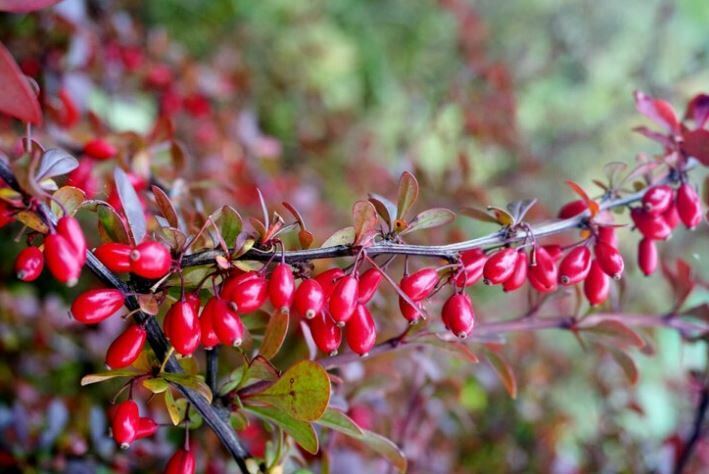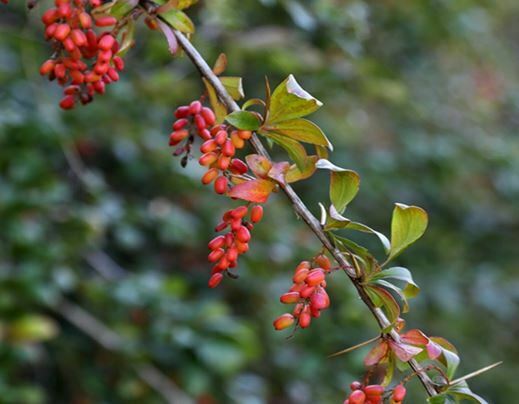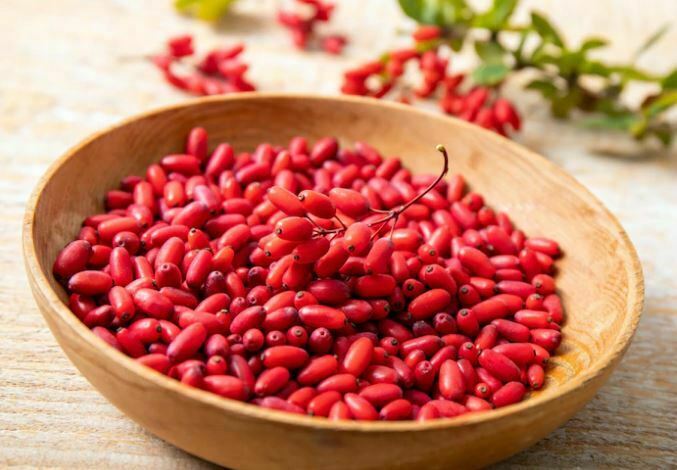Barberry (Berberis vulgaris L.), which belongs to the Berberidaceae family, is a 1-2 meter tall, shrubby plant.
This article consists of two parts. In the first part, general information about the barberry plant is given. In the second part, which is the part below, information about the health benefits and consumption of the barberry plant is given.

The barberry fruit is bright red-pink and approximately 1 cm long. It is slightly larger than a grain of rice in size. The barberry fruit has a sour taste. However, barberry fruit juice is one of the most delicious fruit juices you can drink on earth.
The barberry plant grows spontaneously in many parts of Europe, Asia,North America and the Northern Anatolia Region of Turkiye. The barberry plant is a bush that sheds its leaves in winter and can grow up to 2 meters.
The leaf arrangements of the barberry fruit are spiral, single, or in a bouquet. It usually has a light green, short-stemmed, oval, leathery structure, reddish edges, and a stinging and toothed leaf structure.
It has flowers that look like a compound cluster or cluster. In addition, there are 6 cups, crown organs, and six male and one female organ. The fruit is grape-like, red-yellow, or dark red. The fruits are half the size of the leaves, have 2-3 seeds and are located under short shoots.
While some types of barberry fruit grow in shady, humus, and moist soils, some species also grow well in sunny and dry soils.
Many species of barberry are grown as ornamental plants due to their attractive flowers and fruits, and their fruits are a valuable food source for birds.

Scientific studies on its pharmacological and chemical content and properties are still ongoing and are a subject of research.
Health Benefits of Barberries (Berberis vulgaris L.)
The barberry plant is widely used by local people in traditional treatment practices. For example, the barberry plant is used locally in Turkiye due to its antibacterial, antipyretic, itching, allergy relieving, and rhythm disorder regulating properties. In addition, in interviews with local people who consume barberry in the regions where the barberry plant grows, it is generally stated that it is good for diabetes and blood pressure.

Like many other wild fruits, The barberry fruit is an excellent source of antioxidants. Many scientific studies have reported that its antioxidant activity is relatively high.
In addition, it has a high level of phenolic and anthocyanin compounds. It also contains ascorbic acid (vitamin C), vitamin K, resin, tannin, several triterpenoids, many phytochemicals, more than ten phenolic compounds and more than 30 alkaloids. It contains important alkaloids such as berberine, berbamine, jatrorrhizin, columbamine, berberubin, oxycanthine and palmatine.
It is reported that barberry fruit’s potassium, calcium, magnesium and phosphorus content is higher than that of many cultivated plants.
It also contains flavonoids such as quercetin and kamferol. Based on this, barberry fruit is a good source of bioactive phytochemicals.
Barberry fruit has many effects such as being anti-allergic, reducing inflammation and edema, being a vasodilator, being antimicrobial, being antioxidant, and being antithrombotic. In addition, it is reported that the phenolic acids in the fruit have the potential to have a protective effect against fatal diseases such as cancer and coronary heart disease.
According to the data obtained from academic studies, barberry fruit can treat many diseases, such as skin diseases, infectious diseases, heart diseases, and even psychiatric disorders. In addition, it is reported that it can be used in the treatment of liver diseases and gallbladder disorders; it gives very beneficial results for diabetic patients, especially type 2 diabetic patients.
It is stated that its leaves treat colds and positively affect urinary tract disorders.
The root and root barks have diarrhea-inducing, intestinal cleansing, diuretic, antipyretic and antiseptic properties. The roots of the barberry plant are known among the public as “amberparis root” and are used by the local people as an appetite stimulant, tonic and antipyretic.
In addition, it is also stated that this plant can be used in the form of a cream for some skin diseases and wounds.
When evaluated separately with the fruit, leaf and root parts, it has the following medical effects;
• antimicrobial,
• antiemetic,
• antipyretic,
• anti-pruritic,
• antioxidant,
• anti-inflammatory,
• hypotensive,
• antiarrhythmic,
• sedative,
• antinociceptive and
• anticholinergic.
In this context, the barberry plant can be used in the treatment of diseases and disorders such as;
• cholecystitis,
• jaundice,
• dysentery,
• leishmaniasis (oriental boil),
• malaria,
• gallstones,
• hypertension,
• ischemic heart diseases,
• cardiac arrhythmias and cardiomyopathy,
• diarrhea,
• high fever,
• loss of appetite.
Consumption of Barberry Fruit
Wild plants and fruits are generally known and used by the local people of the region where they are found.
For this reason, many valuable wild fruits are not widely known. In addition, since their properties have not been fully revealed, they need to receive sufficient attention and cannot be evaluated.
Barberry fruit has been used locally and traditionally as a food additive or for treatment for many years. All parts are evaluated differently, from the root and stem bark to the leaves and fruits.
Local people state that the leaves of the barberry plant are collected in the spring and the fruits generally ripen at the end of September.
Barberry fruit is consumed in different ways depending on the people living in the region and their eating habits. It has been determined that it is consumed as fruit juice in many areas during winter. However, it has been determined that it is consumed by adding it to various herbal teas rather than pure herbal tea in almost every region.
Barberry fruit is used in the food industry to produce jam, marmalade, dessert, and wine. In addition, the plant’s root, bark, and fruits can be used as tea.
As can be seen, barberry is a plant that has many health benefits, precious components and high nutritional value. The use of this plant should be expanded. For example, it has a high potential to be added to existing fruit teas for enrichment.
The consumption of wild plants/fruits with many health benefits should be transferred to new generations. We can say that these fruits, which have high nutritional value and an important area of use, are not well known and do not receive the necessary attention around the world.
Products such as pulp, nectar, marmalade, tea and fruit extract can be obtained from these wild fruit species. In addition, it can be used as a filling material in the cake and confectionery industry, enriching other fruit and vegetable juices with vitamins.
Reference:
Karabulut, A. (2018). Berberis vulgaris L. and Berberis crataegina DC naturally found in Bayburt province. Biochemical characterization of wild fruits. Master Thesis. Bayburt University, Institute of Science and Technology, Department of Food Engineering
Here are some articles that might interest you;
Black Rosehip (Rosa pimpinellifolia L.); Overview and Benefits
Wild Apple (Malus Sylvestris); Overview and Benefits
Be First to Comment